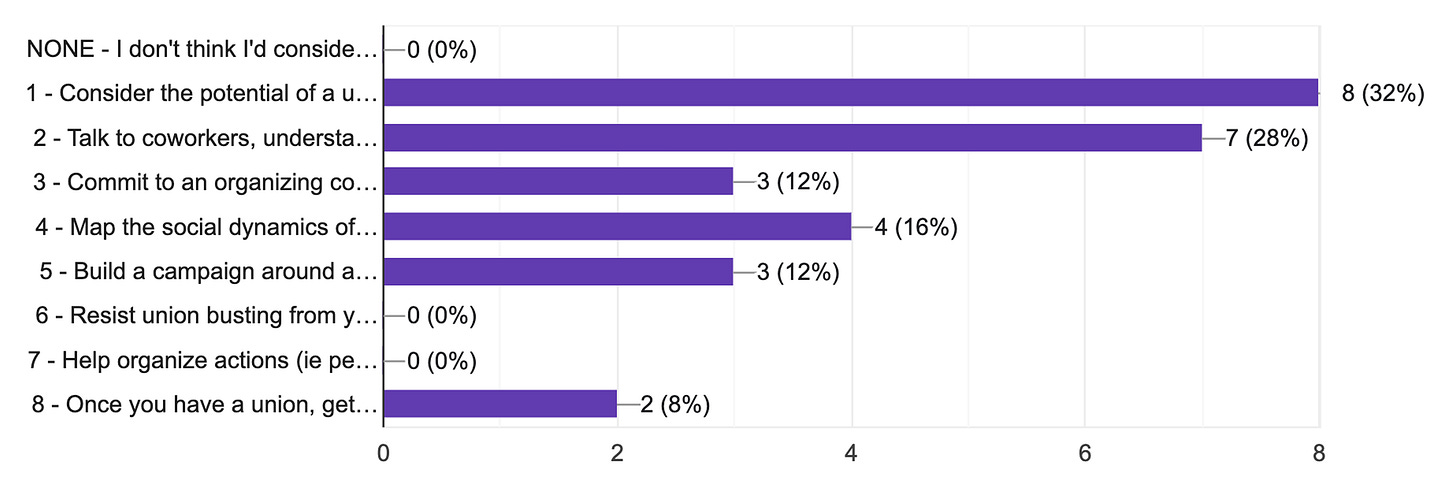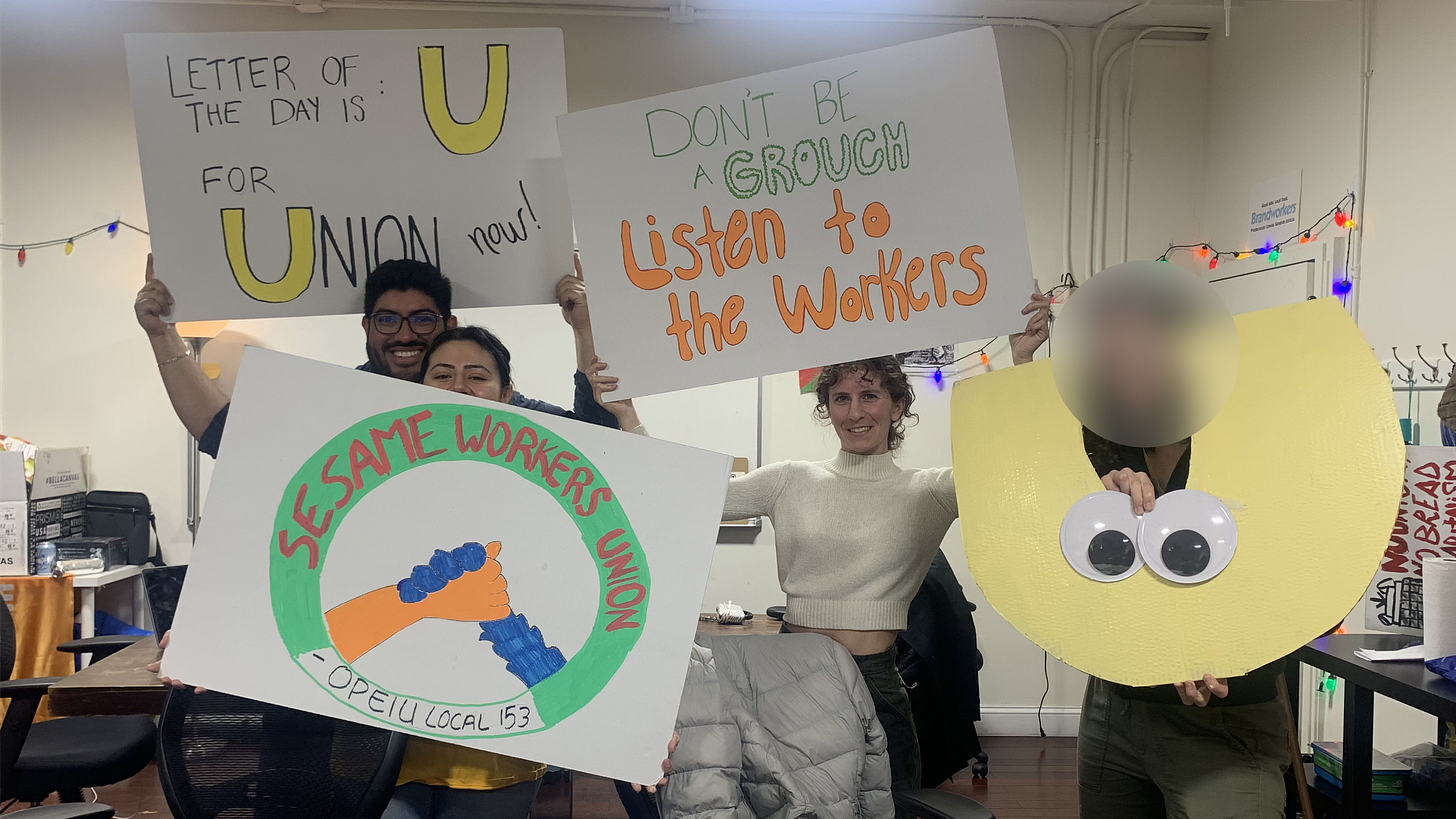Organizing Gym | Collective Power Tools
increasing capacity for worker-led organizing (through experience design)
To my research community,
As my thesis presentation approaches next month (invitation down below!) I’ll be sending a few more installments of this newsletter. I’d love to hear any feedback, thoughts, or reflections you have along the way.
In February, I proposed a service: “1-800-ORGANIZE: Practice Makes Power.” With it, I imagined scaling up how people already on their organizing journey can prepare for coworker conversations by roleplaying with fellow organizers.
This design sprint, I’m focusing on people who are union curious but unfamiliar with organizing. The result: an exercise class that teaches the fundamentals of unionizing through physical movement.
ORGANIZING GYM: Exercise (Y)our Power
Context: Ask a handful of people (I did) with little to no organizing experience what they think it takes to form a union and they may say:
“Dunno”
“Gather a group of people together”
“Meet, write charter, vote”
“I feel like all I know is you should keep it hidden from bosses lol”
“Legal paperwork?”
If they’re curious, they may search online and expect to read a guide. Moving beyond the one-sided intake of information (reading, watching, listening) may involve conversation with an established union organizer and attending trainings. Trainings can risk feeling dry (i.e. watching powerpoint slides), intimidating to access (needing to be “in the know” to find them), and feeling similar to work – perpetuating the slog of doing work outside of work. The more interactive and experiential the training, the better.
With this in mind, I thought: “how might we introduce the process of organizing a union to everyday people in a way that is inviting and energizing?”
What better way to energize than a workout class? In the spirit of showing not telling, have a look:
Here’s how it might work at scale:
Unions and labor orgs partner with local group fitness instructors, providing a workout curriculum complete with exercises, voiceover scripts linking each activity to steps in the organizing process, and debrief questions. The curriculum includes adaptations for different gym setups and variations to ensure it’s as inclusive and accessible as possible.
The exercise class is regularly offered to the public or to specific groups of coworkers who have expressed interest.
Class is in session! Participants are led through a workout where each exercise embodies an element of the organizing process.
Participants gain a clearer understanding of unionizing paired with an endorphin boost from their hard work. They walk away with follow-on resources, “exercise (y)our power” swag, a playlist, and a workout guide.
After my ‘proof of concept’ first class, 100% of participants said they felt more equipped to organize and most reported increased interest in working at a unionized workplace. I also tracked interest in each potential step, asking participants: “Imagine your next workplace has got you down. You've got grievances (be it: compensation, discrimination, benefits, management practices, ethics of the work etc). Select the organizing steps you think you might be interested in moving through:”
While it’s not surprising that resisting union-busting is the most intimidating element of the process, I take this as a note for future communications and trainings to provide more tangible stories and resources to navigate this stage.
Participant testimonial: “I had an amazing time!! I thought it was a super clever and easy way to digest knowledge that might otherwise be harder to understand if you didn’t break it down into a fun workout.”
How’d I Get There?
This concept was born during Emilie Baltz’s course “Design Delight” where she prompted us to prioritize the role of our senses in the design process. By considering sight, smell, touch, movement, sound, and taste, we can create higher engagement and more educational experiences. Her own design practice in the world of food is full of inspiration.
Once I became interested in fitness as my “experience typology” to support organizing, I wanted to learn about organizing happening in the fitness space. I came across the Men’s Health 2020 article “Fitness Trainers Are Organizing to Flex More Muscle in Their Workplaces” and reached out to people with expertise at this intersection. Emily Stewart (group fitness instructor, writer, and labor organizer) and Vivianna Plancarte (NASM personal trainer and SPWU union member) were incredibly generous in offering advice. We walked through my initial class outline and they provided adjustments, new metaphors, and their invaluable expertise to design a safe and accessible workout. While this “Organizing Gym” course is simply a prototype for now, I’d love to collaborate with them in the future to iterate and strengthen the course.
In addition to Emilie, Emily, and Vivianna, I’d like to extend my gratitude to Tao Tao Holmes, Elaine Gao, Julia Lindpaintner, HK Dunston, Allan Chochinov, and the class’s first participants for helping bring this to life.
What’s Next
I’m a new believer in the power of experience design. If “Organizing Gym” or any of the above energizes you as well – I’d love to hear from you!
Bonus Track
If you’re excited by the category of “experience design,” I’d love to share with you the work of Better Block Foundation. In 2013, Better Block came to my hometown Norfolk, Virginia and transformed an area of vacant lots into a vibrant community-run block party complete with local art, small business pop-ups, and ample public space. We experienced it for a long weekend. Not only has the event stayed with me ever since, but it left a lasting impact and solidified the area into Norfolk’s NEON arts district.
Better Block’s work to help people envision a better alternative feels very akin to the mindset shift required in labor organizing. Better Block does this through prototyping that alternate future for people to step into in the present. They build scalable experiences through open-source designs (check out this library!), rapid prototyping, community engagement, and mentorship. On that last note, I had the honor of chatting with Azael Alvarez from the Better Block team during the course of my own experience design process. I think there is plenty more inspiration to be had from Better Block in the labor organizing world.
Thesis Presentation Invitation
On May 7th, I will present my thesis work alongside 14 of my peers. If you’re in NYC and can join us or if you wish to join over livestream – please RSVP on Eventbrite.
I'll close each newsletter with a recommendation per category:
A documentary: MAKE A CIRCLE (shoutout to Workers Unite Film Festival for the screening)
An article: Fitness Trainers Are Organizing to Flex More Muscle in Their Workplaces (mentioned above)
A social media account: @laborontheline
A podcast: Show Us The Ropes: How Touchstone Climbing Gym Workers Unionized Five Locations
A training/offering: Organizing for Power’s Core Fundamentals
An org: Brandworkers
Current organizing to support as a consumer: Sesame Workers United’s petition
If you'd like to chat, share, or give feedback – reply and I’d love to hear from you!
With gratitude,
Erica Fink
PS This newsletter will reach its conclusion come May. Want me to skip your inbox? No problem – just click unsubscribe down below.


